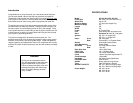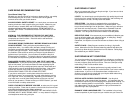17
brakes are maintenance free and need no adjustment. If you have
difficulty braking or using your coaster brake, take your bike to a bike
dealer for inspection. The coaster brake arm is attached to the frame with
a bolt and nut. For the coaster brake to perform, the arm must be
secured tightly at all times. INSPECT THE COASTER BRAKE ARM
ATTACHMENT REGULARLY FOR TIGHTNESS OF THE BOLT AND
NUT.
BASIC MAINTENANCE
You have made a wise decision on purchasing a HUSKY bicycle. To
make sure that it stays in good condition for many years of service and
riding pleasure, we suggest the following:
CLEANING AND LUBRICATION
Keeping your bicycle clean not only enhances the appearance of your
bike, but also helps maintain the performance of vital components. The
following is the recommended procedure for cleaning your bike:
1. Do not wipe off dry dirt or mud as it can scratch the painted surface.
First wet your bike thoroughly with clean water, and then wipe off dirt
with a sponge or cloth.
2. Remove loose dirt on the gears, chain, hubs and wheels.
3. Wipe off wet parts with a clean dry cloth.
4. Excess grease or gum deposits on chain and sprockets can be
cleaned using chain cleaning fluids and degreasers available at your
Husky dealer.
All moving components of the bike require lubrication. Certain
components such as headset, bottom bracket, and hub bearings
should be taken apart by an experienced bicycle technician and
lubricated with special bearing grease. Oil or other lubricants for
such parts should not be used.
You can lubricate the chain using special chain lubricants available at
your authorized HUSKY dealer. Refer to the lubricant manufacturer’s
instructions for proper application.
SCHEDULED MAINTENANCE
If you a do-it-yourselfer, possess technical skills, and have the proper
tools for repair or maintenance of your bike, you can perform most basic
routine maintenance such as lubrication, tire/tube maintenance, adjusting
chain tension, and tightening loose nuts and bolts. We do recommend
that you take your bicycle to an authorized HUSKY dealer for all major
18
adjustments, wheel alignment and truing, component replacement, tire
repair or replacement.
If you ride your bicycle for more than 20 hours a month, we recommend
that you follow a regular inspection and maintenance schedule. Consult
with your authorized HUSKY dealer for a maintenance schedule that fit
your riding style and time.
FIXING A FLAT TIRE
There will be a time when you need to fix a flat tire. You can either take
the bike to a bicycle shop or fix the flat yourself. You can fix a flat
following these simple steps:
TOOLS NEEDED: 2 tire levers, one frame mounted bicycle pump, axle
nut wrench, a rag or cloth, and a tube patch kit.
1. Remove the wheel with a flat tire. If you are removing the front
wheel, you will need to disconnect the front brake cable and brake
arm from the fork.
2. Open the valve and squeeze the remaining air out of the tube. To
open the valve, using a small screwdriver or tip of a tire lever, press
on the valve pin.
3. Loosen the tire bead from the rime by squeezing the flat tire and
pushing it inward. Repeat this all around the tire, making sure that
the bead is loose.
4. Pry one side of the tire bead up over the edge and insert the tire lever
under the bead by about 1/4”. DO NOT USE ANY LEVERS WITH
SHARP POINTS SUCH AS A SCREW DRIVER OR A KNIFE.
5. Pull the tube from under the tire, leaving the tire on the rim.
If you are on the road with a flat tire, we recommend you carry a
spare tube with you. It is much more convenient. You can patch the
flat tube later when you get back home and keep it for later use.
6. Follow patch kit’s instructions for patching the leak. Inflate the tube
before putting the tube back to check for any other leaks. If no other
leaks are found, deflate the tube. Dismount the tire from the rim.
Rub your hand around the inside of the tire to find the cause. Check
the rim for any damage or sharp objects. Wipe the rim and inside the
tire clean.
7. Work one side of the tire over the edge of the rim. The other side
should hang out. Inflate the tube slightly to form a round shape.
Start working the tube under the tire by first inserting the valve into
the valve hole.
8. When the tube is mounted over the rim and under one side of the tire,
try pushing the other side of tire bead over the edge of the rim. Once
you reach the last 2 inches use the palm of your hand to slide the rest
of the tire over the rim. Try not using the tire lever at this time as the
lever can pinch the tube and cause a puncture. Most tires can be
mounted on the rim without the use of a tool.












